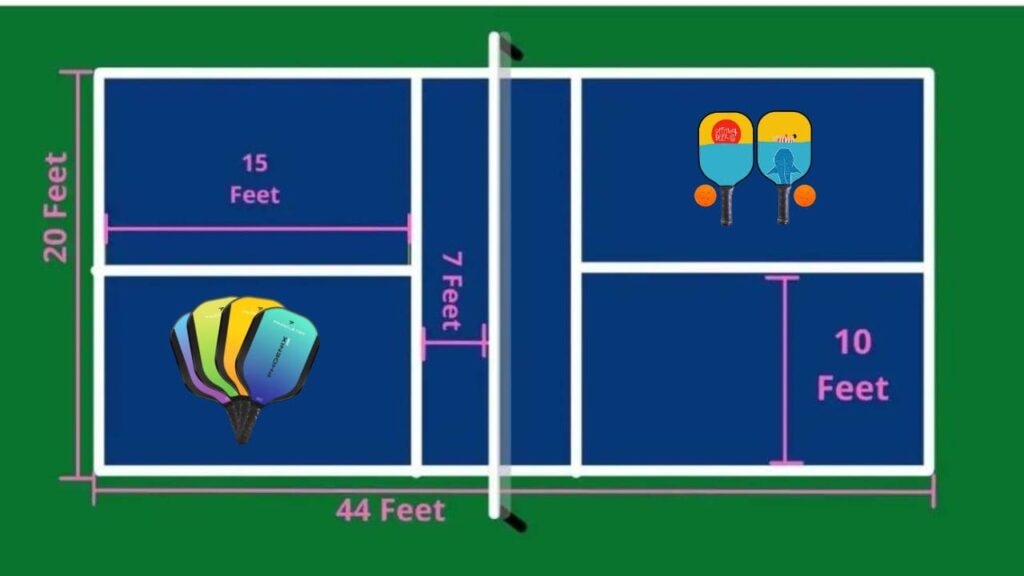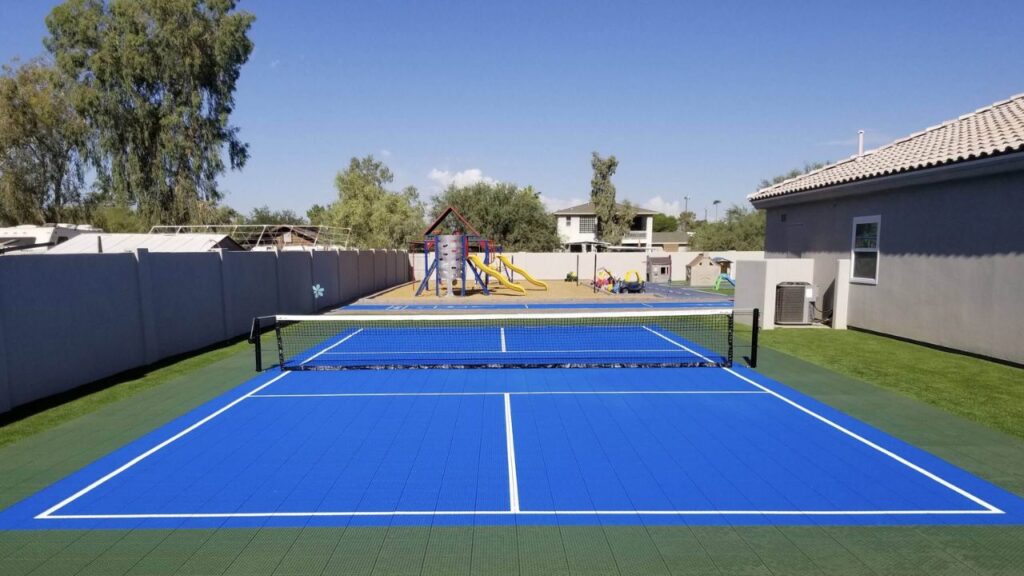How Wide Are Pickleball Court Lines: Pickleball’s explosion in popularity across North America has led to a boom in court construction. With so many new players taking up the sport, there’s growing interest in building regulation-sized pickleball courts to USAPA standards for recreational and competitive play. This article will dive into all the key dimensions, from the size of the court to the width of the lines.
What Are The Regulations For Pickleball Court Size?

Under USAPA guidelines, regulation pickleball courts measure 20 feet wide x 44 feet long for both indoors and outdoors. This equals a total surface area of 880 total square feet. Courts should be measured precisely during construction to ensure adherence to tournament regulations. The uniform size allows for consistent standards across different facilities and competitive play.
Length & Width Requirements
Tournament guidelines specify key length and width dimensions:
- Length: Each side of the court measures 20 feet from baseline to net.
- Width: Courts must span 44 feet wide from sideline to sideline.
- Total Area: A pickleball court’s total square footage should calculate to 880 square feet.
Outdoor and indoor courts must both meet these regulated metrics without exception. Understanding the numbers is key for accurate court building.
Why Is The Court Size Regulated?
Maintaining strict dimensions for pickleball courts enables even, fair, and consistent play across different locations. The carefully calibrated measurements allow players to easily transfer their skills and strategies without needing to adjust for size variations.
Beyond that, regulating court size provides many practical advantages:

- Consistent gameplay experience for recreational and competitive players.
- Transferable techniques and tactics that work court-to-court.
- Uniform specifications for tournament and league approval.
- Streamlined manufacturing for nets, paddles, balls, and other gear.
- Easier facilitation of tournaments, training camps, leagues, and other events.
By adhering to the 20’ x 44’ standards, pickleball organizers can ensure accessible and equitable play across the board.
What About The Court Lines and Markings?
In addition to the court size, pickleball lines, and markings also meet specific width and placement regulations. These include:
- Baseline – The back boundary line spanning the width of the court.
- Sidelines – The side boundary lines running the length of the court.
- Non-Volley Zone Lines – Also called “kitchen lines,” these mark the 7-foot non-volley zone on each side.
- Center Line – The line dividing the two sides under the net.
- Service Courts – The 20′ x 10′ service area boxes on each side.
All lines are 2 inches wide as per USAPA standards. Accuracy is vital for fair gameplay, especially non-volley zone lines where close calls are common.
Additionally, the lines must contrast against the court surface color for visibility. Faded lines on older outdoor courts may need re-striping annually. Indoor-painted sports floors typically hold markings better long-term with multi-year refresh cycles.
Pickleball Net Regulations
In conjunction with court size rules, pickleball nets also meet explicit dimensions. Nets must be:
- At least 21 feet, 9 inches (21’ 9”) long, fully covering the play area.
- 36 inches high at the posts, located precisely 20 feet apart.
- 34 inches high at the center, steadily declining from post height to account for sag.
- Adjustable for tautness – Proper tension prevents contact interference.
Many pickleball nets feature telescoping posts or ratcheting tension adjusters to fine-tune height and tautness as needed over time. Players should check monthly to confirm court and net regulations stay aligned for fair play, especially on outdoor courts subject to weathering.

FAQs
What is the regulation pickleball court size?
20 x 44 feet for a total playing area of 880 square feet. Identical dimensions apply to both indoor and outdoor courts.
How often should the court lines be repainted?
The frequency of repainting the court lines depends on the usage of the court. Generally, it’s recommended to repaint the lines every 2-3 years for outdoor courts and every 4-5 years for indoor courts.
What should I do if the court lines are faded or damaged?
If the court lines are faded or damaged, it’s important to have them repainted or replaced as soon as possible to avoid confusion during play.
Do portable pickleball courts follow size regulations?
Portable courts are usually a bit smaller given space constraints. Typical dimensions are 18 x 36 feet. Serious players may want to confirm court size when traveling for tournaments.
Can existing tennis courts be converted to pickleball courts?
Yes. Tennis courts can easily be converted using temporary boundary lines and adjustable pickleball nets lowered to 34 inches. Some facilities paint dedicated pickleball lines inside tennis courts.
Do backyards meet minimum space requirements for DIY construction?
Backyards often can’t accommodate regulation court sizes. Measure your buildable backyard area before planning permanent builds. Standard portable court sizes may fit better on tighter home sites.
Is there any flexibility or changes expected around court size regulations?
Not at this time – Current court dimensions are well-established by governing bodies after years of refinement, and allow for consistent tournament guidelines worldwide. Major regulation changes are unlikely.
Conclusion:
Now you know the answer to the question, “How wide are pickleball court lines?” They are 2 inches wide and are essential in ensuring fair play. Whether you’re a beginner or a seasoned player, it’s important to be familiar with the dimensions of the court and the width of the lines. This knowledge will help you enjoy the game to the fullest!




